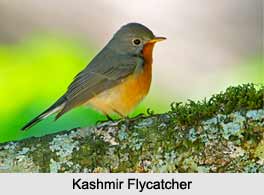 Kashmir Flycatcher is an Indian bird that bears a scientific name "Ficedula subrubra" usually stays in the hills of Central India and Central Srilanka and Western Ghats Mountain Range in India.
Kashmir Flycatcher is an Indian bird that bears a scientific name "Ficedula subrubra" usually stays in the hills of Central India and Central Srilanka and Western Ghats Mountain Range in India.
Category of Kashmir Flycatcher
Kashmir flycatcher is a small passerine bird in the flycatcher family of Muscicapidae. At one time it was considered to be a subspecies of the Red-Breasted Flycatcher, Ficedula parva.
Structure of Kashmir Flycatcher
Kashmir Flycatcher is 13 cm long. It is similar in shape to the slightly smaller red-breasted flycatcher. The male has a grey-brown back with an orange-red throat, breast and flanks, bordered with black on the throat and breast. The female Kashmir flycatcher and first-winter birds have slightly browner upperparts, and the red of the under parts may be reduced to just a pinkish wash. The male of the similar taiga flycatcher, Ficedula albicilla, has the reddish-orange area limited to the throat and the top of the breast, and lacks the black border.
Call of Kashmir Flycatcher
The song of Kashmir Flycatcher is a short melodic sweet-eet sweet-eet-did-he, and the call is a sharp chak.
Population of Kashmir Flycatcher
Kashmir Flycatcher is a vulnerable species with a decreasing population and breeding range, which is also severely fragmented as a result of the destruction of temperate mixed deciduous forests by commercial timber extraction, agriculture and livestock grazing. The population is thought to be between 2,500 and 10,000 birds.
Breeding of Kashmir Flycatcher
Kashmir Flycatcher is an insectivorous species. It breeds in the north-west Himalayan Mountain Range in India in the Jammu and Kashmir region of the Indian states.
Migration of Kashmir Flycatcher
Kashmir Flycatcher is migratory and winters in the hills of central Sri Lanka and the Western Ghats Mountain Range of India.
Habitat of Kashmir Flycatcher
Kashmir Flycatcher breeds and habitats in deciduous forest with dense undergrowth, nesting in a hole in a tree and laying 3-5 eggs which are incubated by the female. It winters in gardens, tea estates, forest edges, and open areas within forest, generally above 750 meters.
Behaviour of Kashmir Flycatcher
Most Kashmir Flycatchers leave the breeding grounds in September, arriving in Sri Lanka in October and departing again in late March.



















